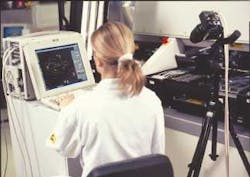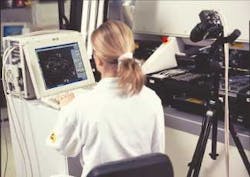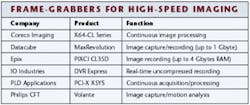High-speed technologies challenge Camera Link
Since its introduction more than three years ago, the Camera Link standard has alleviated many of the problems associated with custom cabling and data-transmission limitations between cameras and frame grabbers. The October 2000 Camera Link specification says, "The Camera Link interface will reduce support time, as well as the cost of that support. The standard cable will be able to handle the increased signal speeds, and the cable assembly will allow customers to reduce their costs through volume pricing."
While most of the benefits promised by the specification have been realized, the hope of many in the industry was that Camera Link would progress into a "plug and play" interface, such as USB and FireWire, and that the standard would evolve to address the demand for increased data-transmission rates, special communication protocols, or smaller connectors and more flexible cable. Today, it simply remains a monolithic hardware standard for connecting high-speed data ports between two products. To allow both products to operate seamlessly together, DLL and APIs still need to be specifically tailored for each combination.
Maintaining strict adherence to the specification was the challenge for Basler Vision Components (Ahrensburg, Germany; www.baslerweb.com) when designing its A504 series of high-speed cameras. "We were faced with a dilemma: implement the Photobit (now Micron) MV13 CMOS sensor, which is 1280 × 1024 at 500 frames/s, into a camera while maintaining Camera Link compatibility," recalls Michael Melle, US sales manager for Basler Vision Components. "It became clear that we could not satisfy both requirements."
To interface its product with the full version of the Camera Link interface, Basler took engineering artistic license, redefining such pins as the TX26 as a video data-transfer pin, instead of the Camera Link's standard data valid (DVAL) definition. "Because there are a limited number of output and control lines in the standard and the A504k/kc does not use the DVAL bit," says Melle, "we redefined DVAL to transmit video data bits." By doing so, the company could still use two Camera Link connectors to offer a pseudo-Full implementation of the standard.
According to Melle, reaction in the industry has been mixed. While some systems integrators do not particularly care that the company has defined a product-specific version, others are more skeptical, feeling that no one should deviate from the specification or attempt to call such products Camera Link-compatible. "Others," says Melle, "feel that the standard never lived up to its expectations, even though the expectations may have been unrealistic. Others debate if Camera Link should be a cable specification, rather than a communication specification." Although Basler did submit its idea to be considered as a Camera Link standard, it was rejected by the Camera Link Committee.
Despite the incompatibility to the Camera Link standard, six frame-grabber vendors are now supporting the A504k/kc by re-engineering the front end of their products to meet Basler's specification (see table). These include Coreco Imaging (St-Laurent, QC, Canada; www.corecoimaging.com), Datacube (Danvers, MA, USA; www.datacube.com), and PLD Applications (Aix-en-Provence, France; www.plda. com), which offer PC-based high-speed image-capture boards that can both capture and process data from the camera, and specialized products from Epix (Buffalo Grove, IL, USA; www.epicinc.com), IO Industries (London, ON, Canada; www.ioindustries.com), and Philips CFT (Eindhoven, The Netherlands; www.cft. philips.com) for image-recording and motion-analysis applications.
High-imaging benefits
Recognizing the benefit of such high-speed imaging, Basler will debut a portable high-speed motion-analysis system dubbed WatchGuard. Incorporating the A504k camera, the CL3SD frame grabber and XCAP software from Epix, hard drive, and DVD storage, the system is targeted at end users who require 1280 × 1024 images to be captured in real time. Using the system, image acquisition can be started and stopped using either the PC or an externally generated electronic signal.
Featuring up to 3 Gbytes of on-board memory, the system can store a real-time sequence of up to 4.8 s at full camera speed and resolution. Using the WatchGuard software, developed with Epix's XCAP package, users can navigate through the acquired images and cut and store images as an AVI file or as a sequence of individual images in TIFF format. Stored files can then be shared over a LAN or stored on the DVD.
While the Camera Link Committee may have been correct in rejecting such obvious deviations from the electrical specification as those proposed by Basler, it may have been prudent to consider other ideas. One such option, for example, would have been to extend the standard by adding additional channels to the specification. In this way, the repetitive data port, line data valid, and strobe control design of the original specification could have been maintained while allowing high-speed camera vendors to remain Camera Link-compatible.
Other standards developments such as 1394b and GigE may eventually erode Camera Link's dedicated user base. Adds Melle, "Camera Link has provided a tangible benefit to the machine-vision industry. What remains to be seen is if the standard can evolve to keep pace with technical and commercial demands.
These include higher data rates, longer cable lengths, and component-specific customization."


